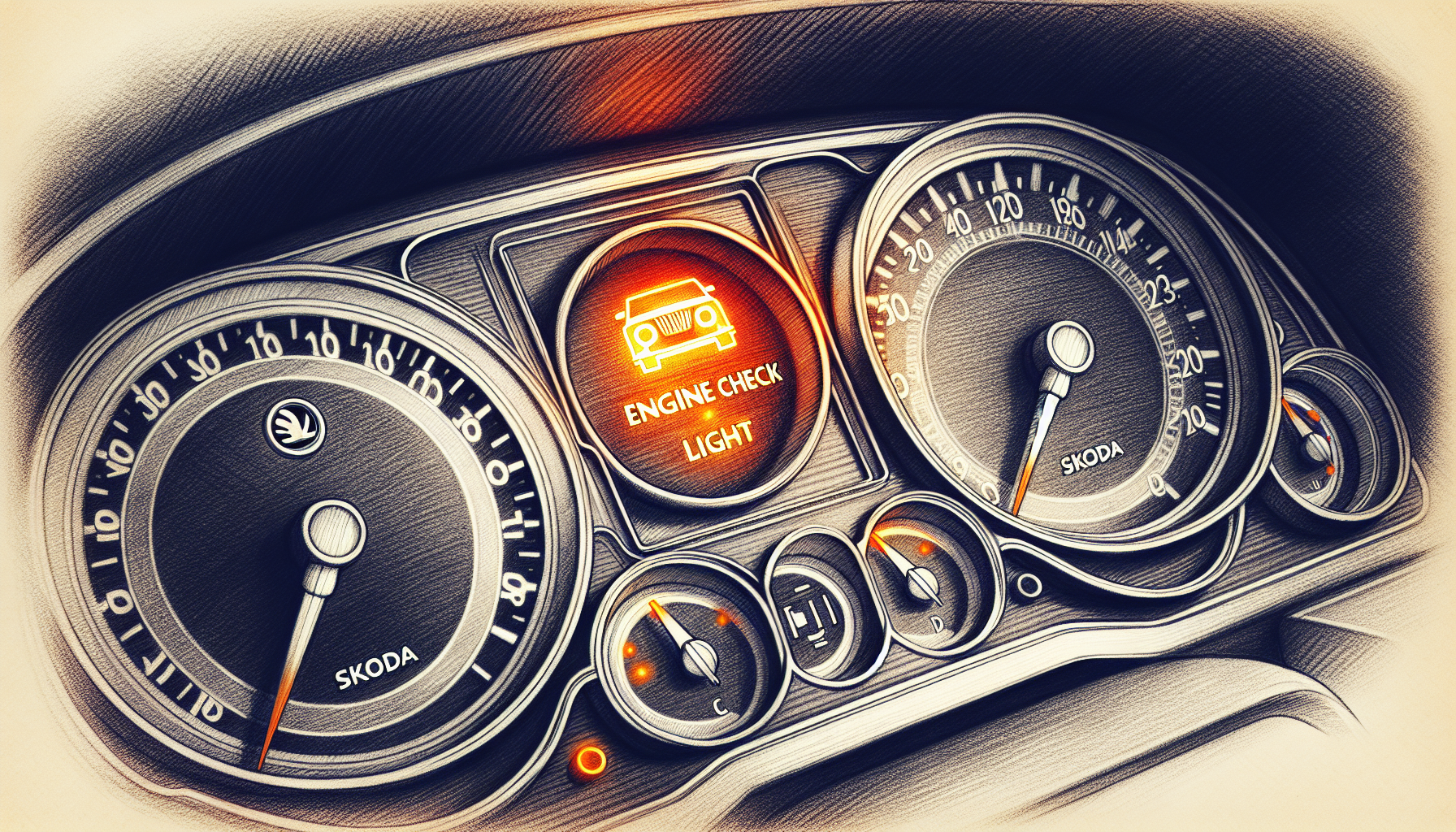The Skoda check engine light signals a problem in the engine compartment. This guide will help you to quickly identify the cause and take remedial action to keep your vehicle safe and operational.
The most important facts at a glance
- The check engine light on Skoda vehicles acts as an important warning system for engine problems, whereby lighting up when starting the vehicle is normal, but is otherwise an indication of a technical problem.
- There are several common causes for the check engine light to come on, e.g. faults in the engine electronics, problems with sensors or the exhaust gas purification system, which can lead to further damage if left untreated.
- Proper diagnosis and correction of the warning signals indicated by the check engine light often require professional tools and expertise; preventive maintenance can reduce the likelihood of problems and influence the MOT test.
Check engine light on Skoda: Meaning and reaction

The check engine light, also known as the “Check Engine” or simply the MKL, makes a crucial contribution to monitoring the engine performance of your Skoda vehicle. It is an important component of your vehicle’s on-board diagnostic functions and acts as a guardian of the engine control unit. It is not an empty warning or a useless flash of light on your dashboard. It is an important indicator that points to possible problems in your vehicle.
Every Skoda driver has experienced it: you start the engine and suddenly the check engine light comes on. But don’t panic! A brief illumination of the check engine light when starting the vehicle is a standard system check and does not indicate a problem. However, if the light comes on or even flashes for no apparent reason, the vehicle should be taken to a workshop for further diagnosis.
Skoda-specific features
On some Skoda models, the check engine light can be triggered by a circuit fault in connection with the diesel particulate filter. This is a Skoda-specific feature that needs to be taken into account.
It is therefore always advisable to familiarize yourself with the specific features and technical specifications of your Skoda model in order to understand exactly what your vehicle is trying to tell you.
Immediate measures when the engine control light is activated
It is important to know how to react if the engine control light is illuminated or flashing. If the light comes on but the vehicle appears to be driving normally, you can continue to drive carefully and should visit a workshop if possible. However, if the light flashes or lights up red, this indicates a more serious fault.
In this case, you should park the vehicle immediately and consult a specialist to avoid consequential damage.
Common causes of an active check engine light on Skoda

There are many reasons why the check engine light comes on. It acts as an early warning system for a variety of problems, which can range from minor to serious. Some of the most common causes are
- Errors in the engine control unit, such as elongated timing chains
- Defects in cam and crankshaft sensors
- Clogged fuel filter
- Problems in the cooling system.
It is important to note that ignoring an active check engine light can lead to costly consequential damage, such as damage to the catalytic converter or timing chain. Improper rectification, such as simply deleting the fault without repair, carries the risk of serious engine damage. It is therefore important to determine the cause of the problem and rectify it professionally.
Lambda sensor and mass air flow sensor
Problems with the lambda sensor and the mass air flow sensor can also lead to the engine control light being activated. Symptoms such as a rough idle when the engine is warm, increased fuel consumption and a car that does not pull properly can indicate problems with the lambda sensor. A defective mass air flow sensor can make itself felt through jerky behavior of the vehicle and reduced throttle response.
A malfunction of these sensors can lead to increased pollutant emissions and fuel consumption, and if these problems are not rectified, this can lead to a rejection during the TÜV test.
Ignition coil and injection system
Faults in the ignition coil and injection system can also cause the check engine light to come on. Rapid flashing of the check engine light indicates serious faults, such as misfiring, which should be rectified immediately to prevent consequential damage.
In Skoda vehicles, problematic pump injector systems, such as those manufactured by BOSCH, can cause the check engine light to activate. Problems with fuel injectors, particularly of the BOSCH type, are known to cause the engine control light to activate in Skoda cars such as the Octavia and Superb.
Exhaust gas purification system
The exhaust gas purification system plays an important role in the operation of your Skoda vehicle and faults in this system can lead to activation of the check engine light. A defect in the catalytic converter can cause the vehicle to fail the main TÜV inspection.
Symptoms such as loss of power at full throttle, starting problems, jerking when driving and smoke from the exhaust may indicate a faulty EGR valve.
Diagnosis and troubleshooting for Skoda

As soon as the check engine light comes on, it is time to diagnose and rectify the problem. An active check engine light should be examined by a specialist, as the error codes require expert interpretation and do not always clearly indicate how the problem can be rectified. Faults that affect the camshaft or crankshaft and impair the combustion process can lead to considerable engine damage and should be noted because of the associated fault codes when the engine control light is illuminated.
The cost of reading out the fault memory in a workshop is typically between 20 and 80 euros, and the process usually takes less than half an hour. It is also possible to use an OBD-2 diagnostic device to delete many faults stored in the fault memory, but the lamp usually lights up again as soon as the diagnostic system detects the fault again.
OBD-II diagnostic devices and Skoda-specific software
The use of an OBD-II diagnostic device can be a valuable aid in troubleshooting. A popular and recommended model is the Carly OBD diagnostic device, which is considered one of the best options on the market. It has been specially developed for manufacturer-specific diagnostics on Skoda vehicles as well as for a large number of other brands. Many OBD-II diagnostic devices can be used universally and, in addition to brand-specific diagnostics, also offer general standard diagnostics that can be used for all vehicle brands.
The use of an OBD-II diagnostic device is essential for identifying and repairing problems indicated by the check engine light. The correct use of this device is crucial for the success of the diagnosis.
Workshop visit or DIY repair?
The decision whether to take your vehicle to a garage or consider a DIY repair depends on the nature of the problem and your technical expertise. Professional interpretation of the fault codes is recommended for the diagnosis of problems signaled by the engine control light, as the complex information from the vehicle computer requires technical expertise.
Purchasing a self-diagnosis device and carrying out repairs yourself without visiting a workshop is only recommended if you have the appropriate technical know-how.
Preventive measures and maintenance
Prevention is better than cure. This saying also applies to the maintenance of your Skoda vehicle. Regular inspections help to reduce the risk of problems with the engine and electronics, which in turn can reduce the likelihood of the check engine light coming on. During these inspections, signs of wear or defects can be detected at an early stage, which can help to prevent major damage.
Many vehicle manufacturers offer special service intervals that are designed to maximize the service life and reliability of vehicles. Regularly checking spark plugs and checking the ignition coil functions can help to prevent problems that could otherwise activate the engine control light. Timely replacement of worn or defective sensors, such as the lambda sensor and the mass air flow sensor, is essential to ensure that the engine functions correctly and to prevent faults.
Regular inspections
Regular inspections are an important part of preventive maintenance. You can significantly reduce the risk of malfunctions of the check engine light. Wear and tear is a normal part of vehicle operation and problems can be avoided through scheduled maintenance and proactive replacement of wearing parts.
Adhering to the maintenance schedule specified by Skoda helps to keep the vehicle in optimum condition and prevent problems. Manual inspections can provide additional safety and detect early warning signals that have not yet led to activation of the engine control light.
Maintenance of sensors and systems
The maintenance of sensors and other systems is another important aspect of prevention. Intermittent roughness at idling speed after a cold start and increased fuel consumption can be signs of a faulty lambda sensor or mass air flow sensor. Sensors such as the lambda sensor and the mass air flow sensor can activate the engine control light if they detect values outside the permissible range.
The use of unsuitable or inferior LED lamps can also trigger the activation of the engine control light.
TÜV relevance of the check engine light on Skoda
For most drivers, one of the biggest concerns when the check engine light comes on is whether their vehicle will pass the next main inspection (TÜV). In fact, an illuminated check engine light can cause the vehicle to fail the MOT test, as it indicates a fault that has not been rectified. It is therefore important that any problems that activate the check engine light are rectified before the main inspection.
The check engine light can indicate faults in the exhaust system, which is particularly relevant for the main inspection (TÜV). Before the MOT appointment, an illuminated defect in the check engine light should be rectified so as not to jeopardize the main inspection.
Effects on the main inspection
An active check engine light is a serious problem that can affect the main inspection. An illuminated check engine light can indicate faults in the exhaust system, which is particularly relevant for the main inspection (TÜV).
It is therefore important that any problems that activate the check engine light are rectified before the main inspection.
Repair of defects before the main inspection
Many defects can be identified and in some cases rectified by the vehicle owner before the main inspection. Errors such as:
- a loose rubber lip on the windshield wiper, which is considered a safety-relevant defect during the main inspection, can be repaired independently.
- Damaged indicators and lighting defects are visible and must be rectified before the main inspection, as they constitute a serious defect.
- Stone chips in the windshield, poorly attached or dirty license plates and defects on the tires can be detected by yourself and should be corrected before the inspection.
During a general inspection, the vehicle registration document should be brought along and the function of the horn, heater fan and seat belt buckles should be checked.
Summary
To summarize, the check engine light is an important tool for monitoring the health of your vehicle. It should not be ignored, but should be seen as a helpful indicator of potential problems. Regular inspections, proper maintenance of sensors and systems and proactive action when the check engine light comes on will ensure that your Skoda vehicle runs reliably and efficiently. Remember: a well-maintained machine is a happy machine!

